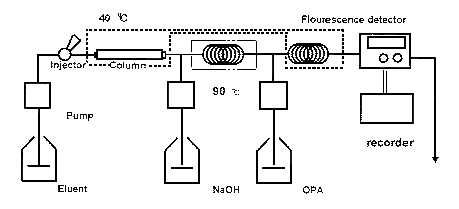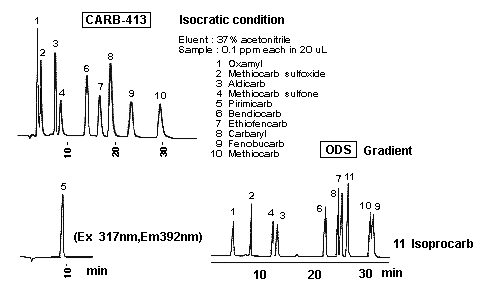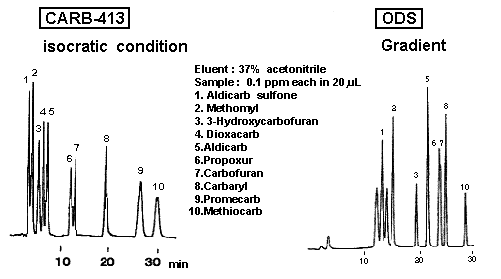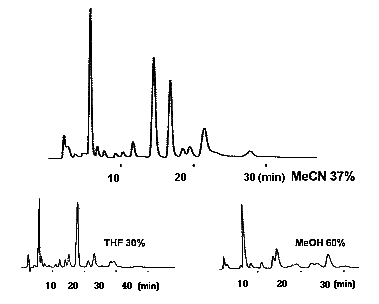N-Methylcarbamates
N-methylcarbamates are widely used as insecticides for agricultural products. Their residual concentration in such products must be monitored in order to keep our health and to avoid environmental pollution. EPM method which uses HPLC is the well-known method. In Japan, Notification No.199 of Japanese Ministry of Health and Welfare for the detection of N-methylcarbamates by HPLC was determined in 1994. According to these methods, N-methylcarbamates are separated by an ODS column using a gradient elution system and is followed by a postcolumn base hydrosis that liberates methylamine, which further reacts with o-phthalaldehyde (OPA)-mercaptoethanol to form a highly fluorescent isoindole. This is a very sensitive the method. However, the method must be performed under gradient elution conditions, and requires additional time and equipment. RSpak CARB-413, which is packed with a polymethacrylate polymer gel realized the simple and rapid analysis of N-methylcarbamates because it can analyze N-methylcarbamates with isocratic elution without using gradient elution. The following is the system to be used for the analysis of N-methylcarbamates.

The following is the analysis conditions:
Column : RSpak CARB-413 (4.6mmID*150mm)
Eluent : 37% Aetonitrile in distilled water
Flow rate : 0.8mL/min
Hydrolysis reagent : 0.05M NaOH
Reaction temp. : 90deg-C
Reaction time : 0.1min
Flow rate : 0.4mL/min
Derivertive reagent : 0.05% o-phthalaldehyde, 0.1% mercaptoethanol
Reaction temp. : 40deg-C
Flow rate : 0.4mL/min
Detector : Fluorescence detector (Ex.340nm, Em.450nm)
(Ex.319nm, Em.392nm for pirimicarb)
Sample volume : 20micro-L
The comparison of anaysis of N-methylcarbamates standards using RSpak CARB-413 column with isocratic elution and that using ODS column with gradient elution.
A good result was obtaioned using RSpak CARB-413 column. The time required for one anaylsis is almost same for both two cases. But, additional time is necessary required for reconditioning the system in the case of gradient elution though such additinal time is unnecessary in the case of isocratic elution. As the serult, total average time required for one analysis with isocratic elution is about half of that with gradient elution.

Sample :
1. Oxamyl
2. Methiocarb sulfoxide
3. Aldicarb
4. Methiocarb sulfone
5. Primicarb
6. Bendiocarb
7. Ethiofencarb
8. Carbaryl
9. Fenobucarb
10. Methiocarb
Column : RSpak CARB-413 (4.6mmID*150mm) Other conditions : Refer to Analysis Method of N-methyl Carbamates
The comparison of anaysis of N-methylcarbamates standards using RSpak CARB-413 column with isocratic elution and that using ODS column with gradient elution.
A good result was obtaioned using CARB-413 column. The time required for one anaylsis is almost same for both two cases. But, additional time is necessary required for reconditioning the system in the case of gradient elution though such additinal time is unnecessary in the case of isocratic elution. As the rerult, total average time required for one analysis with isocratic elution is about a half of that with gradient elution.

Sample :
1. Aldicarb sulfone
2. Methomyl
3. 3-Hydroxycarbofuran
4. Dioxacarb
5. Aldicarb
6. Propoxur
7. Carbofuran
8. Carbaryl
9. Premecarb
10. Methiocarb
Column : RSpak CARB-413 (4.6mmID*150mm) Other conditions : Refer to Analysis Method of N-methyl Carbamates
The retention time of N-methylcarbamates can be shortened by increasing organic solvent concentration.
Since RSpak CARB-413 is a polymer-based column, it can be used in the range of pH 2 to 12.
As organic solvent, THF and methanol as well as acetonitorile can be uesd. Different elution patterns were obtained accoding to the kind of organic solvent.

Sample : Grapefruit
Column : RSpak CARB-413 (4.6mmID*150mm) Other conditions : Refer to Analysis Method of N-methyl Carbamates
